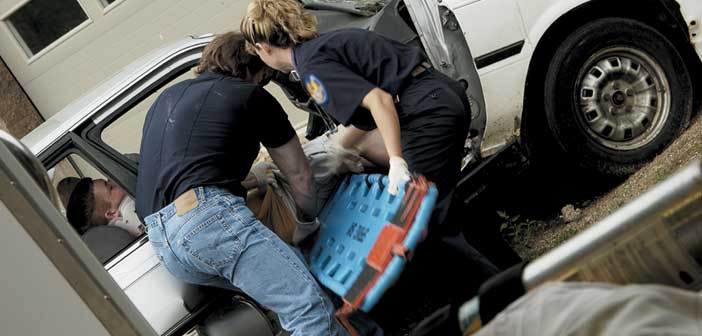ESPANOLA—A report delivered to the Manitoulin Sudbury District Services Board (DSB) by DSB Chief of EMS Michael MacIsaac pointed out that although the costs of municipal emergency services are at an all-time high, and that the EMS Department makes up 46 percent of the overall DSB budget, when compared to other regions in the North, costs are actually below average.
Mr. MacIsaac started out by giving a short history of land ambulance services in the DSB. “In 1999, the provincial government downloaded responsibility for land ambulance in Ontario to the upper tier municipalities,” he said. “In this region’s case, responsibility fell to the DSB. At the same time as the download was occurring, a change was made to the schooling required to become a paramedic. The former one-year certificate course in community colleges became a two-year diploma course in the year 2000.”
Mr. MacIsaac noted, “the impact of both events occurring at the same time had massive side effects. First, newly established municipally-led ambulance services were finding that their areas were underserviced in meeting the needs of their citizens. The former Ministry of Health and Long Term Care-appointed contract providers were working under a level of effort system coordinating a historic system, not looking in great detail to the current need.”
The result was that a lot of municipalities found themselves being underserviced for some time and so began to expand—with the larger urban centres expanding at a rapid pace, he said. “Second, there was a year where there were no paramedic program graduates.” This resulted in a decrease in supply of qualified EMS personnel at the same time that there was an expanded demand for their services. “Therefore a rise in costs,” he said. Municipalities began competing with each other with signing bonuses. “Not only were paramedics getting full-time jobs right out of school, but some were getting bonus pay to work in one area versus another. I myself was offered a bonus of $4,000 by the Halton area. The Golden Horseshoe was driving everything.”
Along with this highly competitive recruiting regime, the provincial download meant that paramedics were now in the municipal realm. “They started to compare themselves to the other municipal based emergency services (fire and police),” he said. “In some instances paramedics in urban areas were co-located with fire services within traditional fire halls.” Although this did help in containing costs, it also provided an opportunity for “two dissimilar services to compare and contrast many things associated with their jobs, including workload and compensation,” he continued. “Paramedics began to feel their profession was undervalued.”
With an aging population getting sicker and generating more emergency calls, the perfect storm had arrived to escalate costs. “Wages in the late 1990s were generally $20 an hour,” he said, pointing out that the average wage for a primary care paramedic in 2013 has risen to $35.44 per hour.
Despite all these pressures, at two percent, the DSB wage increases over the last five years have remained below the provincial (2.09 percent) , and even the Northern EMS average (2.05 percent). Fire service wages over the same period have risen provincially by 3.41 percent, while police services have risen 2.89 within the Toronto Police Services and 3.29 percent with the OPP.
“It must be understood that the police and fire services do not have the right to strike and immediately go to interest arbitration if a bargained agreement cannot be arranged,” he said.
[pullquote]“It must be understood that the police and fire services do not have the right to strike and immediately go to interest arbitration if a bargained agreement cannot be arranged,” he said.[/pullquote]
The simple fact of the matter, said Mr. MacIsaac, is that looking forward, while the DSB has not yet had to proceed to interest arbitration, the board must be prepared to realize that it is a real possibility if a deal cannot be arranged. When such arbitration comes about, arbiters look around for comparisons in deciding what a fair wage settlement would be.
Workload was another component that the EMS report looked at. In each category, the ratios in the DSB indicate that more is being done with a lot less than in the surrounding regions.
In managers per station, the Northern average is 0.8 to 1, in the DSB it is 0.58 to 1; in ambulances per station, the Northern average is 2.7 to 1 (without Sudbury and Thunder Bay that average rises to 2.8 to 1); in managers per administrative support, the Northern average is 3.1 to 1 (3.4 to 1 without Sudbury and Thunder Bay) while the DSB is 7 to 1; in managers per paramedic, the Northern average is 0.3 to 1, while in the DSB it is 0.27 to 1; and finally, in total staff per administrative support, the Northern average tops out at 14.7 to 1 (16.6 to 1 without Sudbury and Thunder Bay), while the DSB is a whopping 33 to 1.
“We are managing quite efficiently,” said Mr. MacIsaac. “The EMS department is not overinflated and, in reality, can be considered quite lean in comparison to our closest colleagues.”




